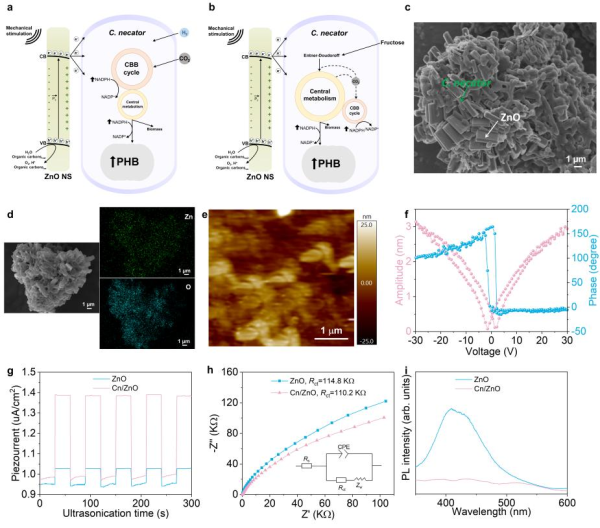
Recently, the research team led by Professor Zhang Tian from the School of Chemistry, Chemical Engineering and Life Sciences at Wuhan University of Technology (WUT) made significant progress in the sustainable utilization of carbon dioxide (CO₂) in biological systems. Their findings, entitled “A biopiezocatalyst harnessing mechanical energy to enhance bioplastic production from CO₂ and organic carbon”, were published in the internationally renowned journal Nature Communications. WUT is the only affiliation listed for the corresponding author and all co-authors. Professor Pier Luc Tremblay is the first author of the paper, and Professor Zhang Tian is the corresponding author.
Addressing the long-standing challenge of low efficiency in CO₂ conversion by autotrophic microorganisms, Professor Zhang’s team innovatively integrated the autotrophic bacterium Cupriavidus necator with zinc oxide (ZnO) nanosheets, a piezoelectric material. By harnessing the piezoelectric effect of ZnO, mechanical energy—such as ultrasonic vibrations and wave motion—was converted into electricity, which promoted intracellular electron transfer in microorganisms. This approach significantly enhanced the efficiency of converting CO₂ into bioplastics. Moreover, under mechanical stimulation, the system also demonstrated enhanced heterotrophic bioplastic production when fructose was provided as an organic carbon source. This pioneering work opens a new avenue for driving microbial metabolism with mechanical energy to synthesize multi-carbon organic compounds.
The study establishes a novel hybrid strategy of mechanically driven biopiezo-catalysis for CO₂ utilization, offering new perspectives for sustainable green biomanufacturing with strong industrial application potential.
Professor Zhang’s team has long been devoted to the development and application of advanced green bioenergy technologies and materials. By integrating knowledge and techniques from microbiology, synthetic biology, electrochemistry, and materials science, the team has achieved a series of research breakthroughs in CO₂ valorization, microbial electrosynthesis, bioremediation, DNA sensing, and geomicrobiology (Chem. Eng. J. 2021, 418, 129357; Trends in Biotechnology 2017, 360–371; Science 2015, 350, 738–739).

Paper Link: https://doi.org/10.1038/s41467-025-63576-y
Written by: Han Wei
Rewritten by: Liang Muwei
Edited by: Li Huihui, Li Tiantian
Source: School of Chemistry, Chemical Engineering and Life Science
|
|